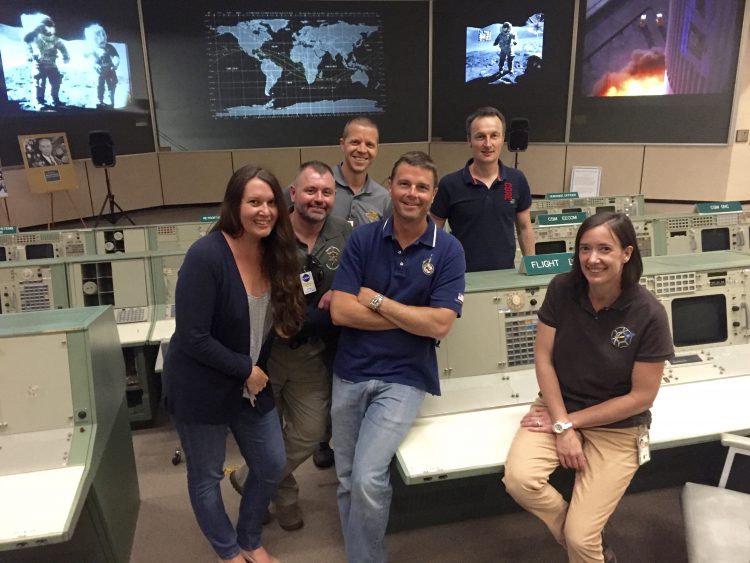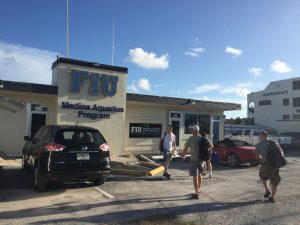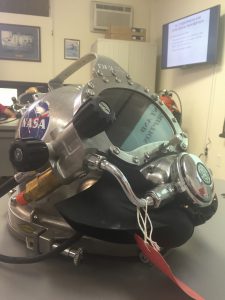Back to all Blog posts
NEEMO 21 Crew Training Begins!
Dawn Kernagis // July 11, 2016

Published 7.11.16
The fun begins!
During June 2016, the NEEMO 21 crew underwent their first round of crew training at Johnson Space Center. In addition to reviewing mission protocol, objectives, and safety, we specifically trained on numerous mission science objectives, including vestibular function testing, exercise equipment, medical telemetry, and learning about a variety of software and hardware that the crew will be testing throughout the mission. Next, our training moved to the Florida Keys….
On Sunday, July 10th, the NASA NEEMO 21 crew started their on-site training week at The Aquarius Reef Base (ARB) in Islamorada, Florida. The first day was comprised of FIU ‘working diver’ checkout dives and a chance to see the Aquarius habitat and surrounding landscape firsthand, supervised by Mark “Otter” Hulsbeck and Otto Rutten from FIU’s ARB. The on-water and in-water experience between these two is beyond the pale – more stories to come from these two as the mission progresses 🙂
The skills checkout involved basic SCUBA drills, from mask flooding and clearing to buddy breathing to navigation (with neutral buoyancy, of course!). While we conducted basic skills at a sandy patch near Aquarius habitat for the first dive, we did the more advanced skills at the Aquarius site for the second dive! The photos and video I have seen of the habitat don’t do it justice – the coral-covered structure stands proud against a back drop of aqua, and the marine life and colors around the entire site are stunningly vibrant. We were all grinning ear to ear as we descended upon our soon-to-be undersea home! We even had a chance to stick our heads into the ‘moon pool’, where we will be entering and exiting the habitat on a regular basis. Otter and Otto demonstrated the difficulty of whistling, and we all had a good laugh at our high-pitched voices that are a result of the higher air density before finishing up dive #2.

The crew arrives for their first day of training at FIU’s Aquarius Reef Base, Islamorada, Florida.
Everyone rocked their checkout dives on Day 1! We then moved in a different direction from conventional SCUBA to learn about diving with a surface supplied diving system from ARB’s Operations Director, Roger Garcia. Roger is responsible for overseeing diving operations and assuring the safety of all participants. He has a 20 year history of diving operations with the US Navy and has been with ARB since year 2003. As with all of the ARB staff, his vast experience shines as he walked us through the equipment and the safety of diving surface supplied rigs.
As a crew, we are diving the Kirby Morgan 37 SS (stainless steel) helmet when we leave the habitat to go on a simulated spacewalk. A beautiful piece of equipment that, combined with a specifically-designed umbilical assembly, will allow the crew members to have a secure gas supply alongside communication and video capabilities between the extravehicular (EV) dive crew and the intravehicular (IV) crew and surface Mission Control.
We each took the opportunity to try the helmet on, which was the first time for me! The helmet fits snug around the face, with an oral nasal mask inside of the helmet that we fit around our faces. The helmet weights 32 pounds, so you need a dive tender to help lift the helmet over your head as you are seated and geared up. As the tender lowers the helmet over your head, you pull the chin strap down and get it settled into place so you can cinch it tight once the helmet is on – this ensures that your helmet moves with your head when you turn it! The tender then locks the helmet into place using a fitted neck dam that the diver is already wearing, and you are ready to dive! We are all excited to put the helmet on again for Day 3 and try it out in the water!

The Kirby Morgan Superlite 37 Stainless Steel diving helmet.
After learning about the mechanics of the helmet and the surface supplied system through classroom and hands-on training, we went to the dock of The ARB to check out the equipment set-up for the next several days of Superlite dive training (we also had a visit from the resident manatee!)
Following our Superlite introduction, we switched our focus to the science objectives of the mission. First up was Dr. Jason Kring’s research crew from Embry-Riddle Aeronautical University, who taught us about their optical communications study that we will be conducting during the mission. We then met with Ken Nedimyer, Director of the Coral Restoration Foundation, to get hands-on training with the equipment and protocol for the coral restoration project will be working with throughout the mission. Finally, the crew trained on equipment and protocol for sample collection and software that we will be using through the mission.
For the next three days, we will be focusing on in-water training with the Superlites and much more training on the research projects we have in store over the next several weeks. The crew, research, dive, and support staff makes up an exceptional team, and we are all beyond excited about the upcoming mission!
For more updates, follow Dawn @ https://twitter.com/dawn_kernagis
Latest Blog Posts
- Mission Day 11: Orbicella faveolata, where art thou? August 05, 2016
- Mission Days 9-10: Settling in Undersea August 01, 2016
- Mission Day 7-8: Remembering Where We Are July 28, 2016
- Mission Day 6: Home is Where the Heart Is July 27, 2016
- Mission Day 5: Tales from the Topside July 26, 2016
- Mission Day 4: Time at Depth July 24, 2016
- Mission Day 3: It Takes a Village July 23, 2016
- Mission Day 2: Life Aquatic July 23, 2016
- Mission Day 1: Splash Down! July 21, 2016
- Countdown to Splash Down July 17, 2016
- Topside, this is Green Diver July 13, 2016
- NEEMO 21 Crew Training Begins! July 11, 2016
- Welcome to NEEMO 21! July 06, 2016

